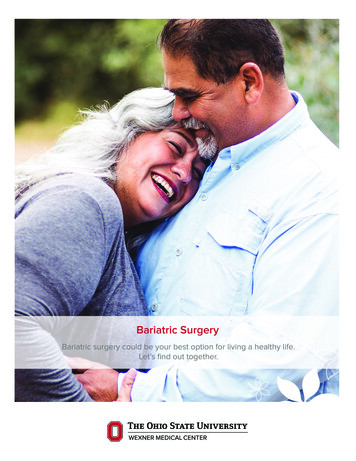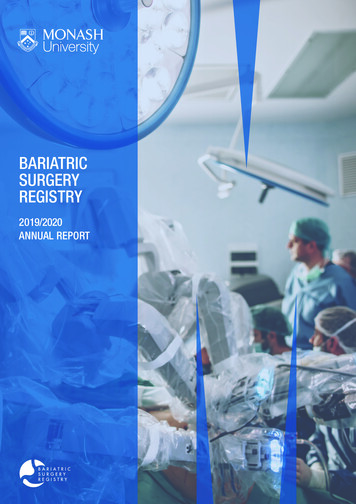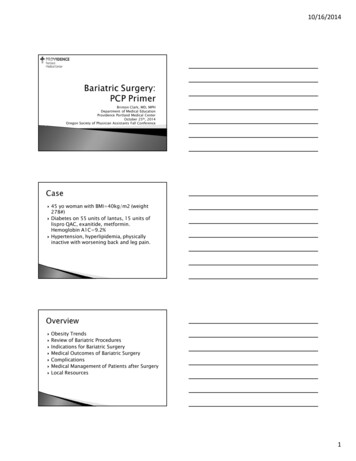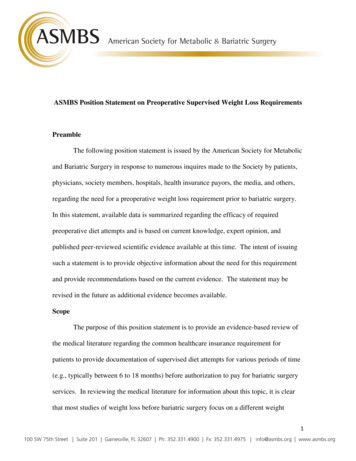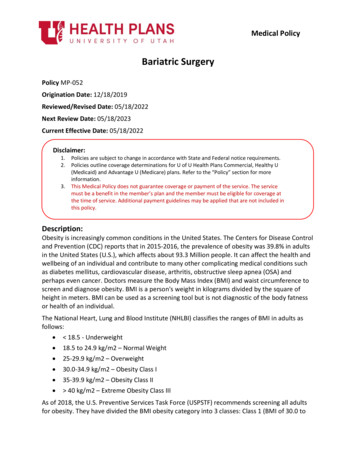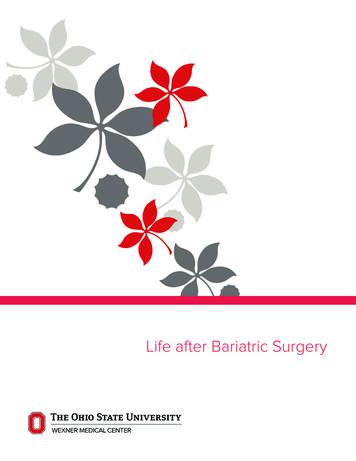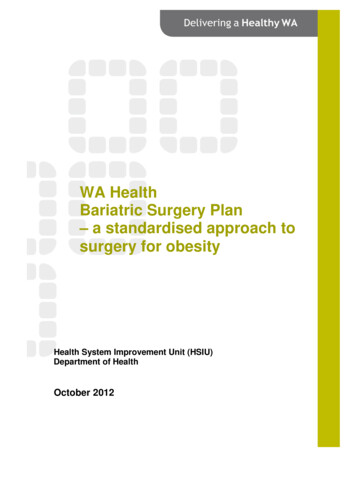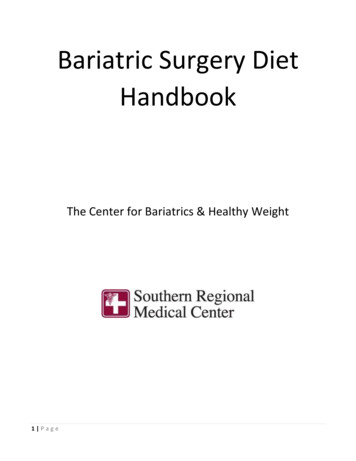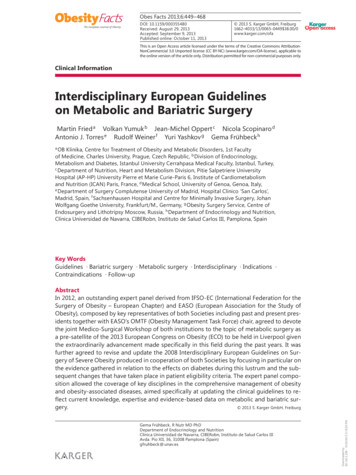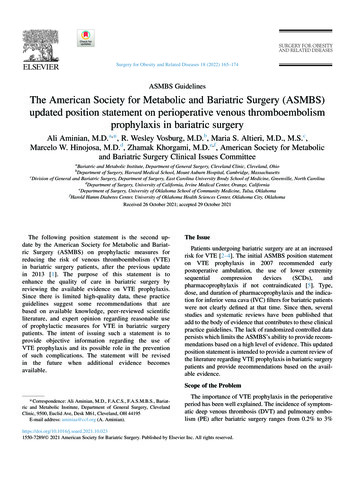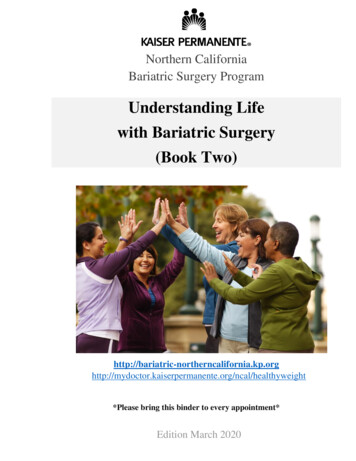
Transcription
Northern CaliforniaBariatric Surgery ProgramUnderstanding Lifewith Bariatric Surgery(Book t*Please bring this binder to every appointment*Edition March 2020
Northern California Bariatric ProgramTABLE OF CONTENTSTABLE OF CONTENTS . 2Chapter 1. Introduction to Life with Bariatric Surgery. 6Introduction . 6The upsides (benefits) . 6The downsides (restrictions, side effects and complications) . 6Chapter 2. Nutrition, Food, and Eating . 7PART 1: UNDERSTANDING CALORIES, PROTEINS, CARBOHYDRATES, FATS, andFLUIDS. 7Calories . 7Protein . 8Carbohydrates . 9Fat . 11Fluid Requirements . 12PART 2: READING LABELS AND UNDERSTANDING CALORIES ABSORBED . 14Reading Labels and Calories . 14Digestion determines the actual calories you get . 14PART 3: PLANNING A 1200 CALORIE MEAL PLAN and FOOD LISTS . 161200 Calorie Meal Plan with 2 Dairy Servings . 161200 Calorie Meal Plan with 1 Dairy Serving . 171200 Calorie Meal Plan with No Dairy Servings . 17Lean and Medium-Fat Proteins List: (Meat and Meat Substitutes) . 18Non-Fat (Skim) and Low-Fat (1%) Dairy List . 20Protein Supplements List . 21Non-starchy Vegetables List . 23Starches List . 25Fruits List . 28Fats List . 30PART 4: BARIATRIC DIET STAGES . 33STAGE 1: Clear Liquids with Protein Supplements . 35STAGE 2: Modified Liquids . 37STAGE 3: Soft and Moist Solids . 39STAGE 4: (Your Lifelong) Regular Bariatric Diet . 42Edition March 2020pg. 2
Northern California Bariatric ProgramPART 5: HABITS, MEAL PLANNING, and TOOLS FOR SUCCESS . 46Develop Successful Lifelong Habits when eating. . 46Meal Planning . 47Restaurant Survival After Surgery . 48Cooler Emergency Kit . 50Chapter 3. Vitamin and Mineral Supplements . 51Supplements for Roux en Y Gastric Bypass or Sleeve Gastrectomy . 51How to Choose Your Supplements and Other Tips . 51The Supplements You Need . 52Multivitamin with Iron . 53Vitamin B1 (Thiamin) . 54VITAMIN B12 . 54Iron (Ferrous) . 55VITAMIN D . 56Calcium Citrate . 57Calcium Citrate:Liquid or Chewable Alternatives. 58Specialty “Bariatric” Vitamin/Mineral Supplements. 59Vitamin and Supplement Schedule . 60VITAMIN SUPPLEMENT CHART . 61VITAMIN SUPPLEMENT CHART: Sample schedules . 62Chapter 4. Activity and Exercise . 63EXERCISE and WEIGHT LOSS: . 63EXERCISE and CALORIES . 64OTHER BENEFITS OF EXERCISE . 67EXERCISE GUIDELINES . 68GETTING STARTED . 72EXERCISE MYTHS . 74TROUBLESHOOTING . 75RESOURCES . 78Walking Programs . 78Chair Dancing/Chair Aerobics. . 81Resistance Bands . 82Edition March 2020pg. 3
Northern California Bariatric ProgramKaiser Permanente Resources . 85Chapter 5. Emotional Health and Support . 86Key principles –TOP 10. 87Mindful Eating . 88How do I know if I’m physically hungry or emotionally hungry? . 9210 Steps to Freedom from Emotional Eating By: Nancy Mehegan. 93Emotional Eating Exercise . 95Changing our Thinking . 96Restructuring Negative Thoughts . 97Other ways to untwist your thinking:. 99Transforming your Body Image While You Transform your Body . 101Changing Your Behavior . 103Exercise Program Planning Guide . 106Managing Strong Emotions . 110Common Triggers . 112You and the World: . 115Realistic Thinking About Life After Surgery . 115Unhealthy Behaviors and Bariatric Surgery . 121Support Groups . 124Chapter 6: Side Effects, Complications, and Problems . 126Food intolerance and changes in taste . 126Nausea and vomiting. 126Dehydration and Dizziness . 126Constipation . 127Gas, bloating, and bad breath. . 127Dumping syndrome . 128Hypoglycemia (low blood sugar). 128Hair loss . 129Dental erosion . 130Skin rashes, Intertrigo, and loose skin . 130Plastic Surgery . 130Kidney stones . 130GERD, Heartburn, and Acid Reflux . 131Edition March 2020pg. 4
Northern California Bariatric ProgramUlcers . 132Hormonal changes (i.e. perimenopausal symptoms) in women . 133Pregnancy and Birth Control . 133Smoking, Alcohol, Pot (see overlap with Emotional health chapter) . 133Reoperations . 134Chapter 7: Medications after bariatric surgery . 135Antacids for ulcer prevention, and GERD . 135Nsaids . 135Aspirin. 135Prednisone and steroids. 136Warfarin (Coumadin), Plavix, and other Blood Thinners. 136Anti-depressants, and other Psychiatric medications. 136Thyroid medications . 136Medications that are safe . 137Chapter 8: Weight stalls or gain after bariatric surgery . 138There are many reasons for obesity . 138How does food lead to obesity? . 138Metabolic Adaptation can make fat loss difficult. . 139Understanding the calories in our food can help us understand why we gain fat. . 140How does bariatric surgery help lose fat? . 140You can eat through a small stomach: It does not stretch. 141Why you might eat when you do not need to . 141Why is activity is important. . 142A new operation does not help. 142How do you lose weight again two or more years after bariatric surgery? . 142Chapter 9: Resources . 144Books . 144Kaiser Websites: . 145External Resources and Websites: . 145Fitness/ Calorie Counter Apps: . 147Gym and Workout gear discounts for KP members. . 148KP Heath Education exercise classes. . 148KP Wellness Coach. 148Edition March 2020pg. 5
Northern California Bariatric ProgramChapter 1. Introduction to Life withBariatric SurgeryIntroductionPreparing for bariatric surgery and having the operation is only the very beginning of yourweight loss journey and hopefully a new better life. The operation seems to help most peoplewith weight loss for the first year. Unfortunately, for reasons we do not completely understand,the strong effects of the operation seem to weaken over time, and it becomes easier and easier to“cheat” and eat more than your body really needs. If you continue to do this, you will gain yourweight back and all the benefits of your operation will disappear. But all the downsides willremain. Therefore, we often refer to bariatric surgery as “just a tool” to help you break yourcycle of obesity.For this reason, it is extremely important that you understand how to use your tool properly, andhow to maintain awareness and control of you weight for the rest of your life.The upsides (benefits)Bariatric surgery is only a positive intervention if you can lose enough weight to improve yourhealth, quality of life, and become a more active person. You must lose as much weight as youcan to a healthy range in the first year to year and ½, and then control your eating and activity tostay at that weight for the rest of your life. Maintaining a healthy weight requires lifelongawareness, dedication, and action.The downsides (restrictions, side effects and complications)Whether or not you lose weight, having bariatric surgery means accepting significant restrictionsand risks. You must commit yourself to take vitamins and supplements for the rest of your lifeor you are almost certain to experience significant health problems like weakness, fatigue,anemia, bone loss and broken bones, nerve damage, memory loss, dementia, and many others.With the loss of food, you may be at risk for addiction to alcohol, cigarettes, drugs, opioids, andother unhealthy substances or behaviors. After a gastric bypass, it is dangerous to take NSAIDs(motrin, advil, alleve, etc.) for pain. Finally, even when you do everything right, you have toaccept the risk of side effects (hair loss, bad breath, loose skin, etc.) and complications(reoperations, ulcers, dumping, etc.).This book will cover the changes you need to make to be successful and stay healthy. We willalso review the restrictions and problems you need to be aware of.Edition March 2020pg. 6
Northern California Bariatric ProgramChapter 2. Nutrition, Food, and EatingPART 1: UNDERSTANDING CALORIES, PROTEINS,CARBOHYDRATES, FATS, and FLUIDSCaloriesA calorie is a “unit of energy”. Energy is the ability to do work. Work can be physical, likecarrying a suitcase up the stairs, or biological, like the beats of your heart pushing bloodthroughout your body. When the body gets too many calories from food, it will store those extracalories as body fat.EXTRA calories result in fat gain3,500 calories are equivalent to approximately 1 pound of fatExample: eating 100 calories extra a day 10 pounds of weight gain a yearExample: eating 200 calories extra a day 20 pounds of weight gain a yearExample: eating 200 calories extra a day 100 pounds of weight gain in 5 yearsWhen the body uses more energy than it takes in you will lose weight.NOT ENOUGH calories result in fat loss3,500 calories are equivalent to approximately 1 pound of fatExample: eating 200 calories LESS every day should lead to 20 pounds of fat lost in one year,but this is assuming you increase your activity to keep your body from lowering its metabolism.Edition March 2020pg. 7
Northern California Bariatric ProgramProteinDaily Goal: 60-80 gramsPer Meal Goal: 20-25 gramsProtein is a primary component in every cell and tissue in the body. It is used to make hair, skin,nails, muscles, organs, blood cells, nerves, bone, brain tissue and more! Since your stomachcapacity is severely restricted, you must be sure to eat enough protein every day to keep youhealthy.Protein is necessary to: Preserve muscle tissue and allow the body to lose fat instead of muscle Allow wounds to heal properly Prevent protein deficiency. Signs of protein deficiency include poor wound healing,fatigue, hair loss, muscle wasting and patchy or scaly skin. Reduce your hunger. Protein is more satisfying and filling than carbohydrates. You areless likely to feel the need to snack between meals.Choose Protein First Foods that are high in protein include lean red meats, pork, poultry, fish, cheese, eggs,tofu and seafood At each meal, concentrate on eating protein first. This helps you meet your proteinneeds before filling up on other foods. Be sure to select lean sources of protein to help keep your total fat intake low and tohelp prevent unwanted weight gain. Poultry and fish are lean proteins. Red meat willhave more fat.Keep Proteins Moist After surgery many people have difficulty tolerating dry or tough pieces of meat(Examples: chicken breast, pork and steak). These foods can feel as though they are stuckand may cause pain or vomiting. Remember to prepare protein foods using moist cooking methods, such as, braising orusing a slow cooker. You can try using low-sugar marinades or a small amount of low-fat or fat free gravy tokeep foods moist. Taking small bites and chewing thoroughly is essential.Proteins in Dairy Products Dairy products include milk, yogurt and cheese.These foods are a good source of protein, calcium and vitamin D.Some people become lactose intolerant after surgery, and find Lactaid or low-fat soymilkeasier to digest.Processed milk products such as cheese and yogurt are often better tolerated.Edition March 2020pg. 8
Northern California Bariatric ProgramYogurt is an excellent food choice both before and after surgery. Yogurt contains some proteinand it has a soft texture which makes it easily tolerated after surgery. Some yogurts are processedwith added sugar and may contribute to Dumping Syndrome. When selecting a yogurt, chooseone that has between 15 to 18 grams of “Total carbohydrates”. Avoid “Fruit on the Bottom”yogurts which are high in sugar.CarbohydratesDaily Goal: less than 130 grams per dayCarbohydrates are a major source of energy for your body prior to surgery. After surgery, theneed for carbohydrates is less. Protein and fat become the primary energy sources. Your bodywill still need carbohydrates (for your brain and to fuel muscles for activity). However, aftersurgery you will get most of your carbohydrates in the form of fruits, vegetables and dairy.Simple Carbohydrates: Sugar Sugar is a “simple” carbohydrate and is found in many foods.“High glycemic index” foods contain lots of sugar. “Low glycemic index foods havemore complicated carbohydrates and less sugar. If possible, choose low glycemiccarbohydrates.Before and after surgery, it is important to avoid foods that are high in sugar.Too much sugar can cause dumping syndrome, low blood sugar, and weight regain.Read labels carefully to be sure foods are low in added sugar.o 4 Grams of sugar 1 teaspoon!o This means a soda with 28 grams of sugar has 7 teaspoons of sugar!Added Sugars Foods that contain any of the following types of sugars listed as one of the first 3ingredients are likely to be high in sugar:Anhydrous dextroseBrown sugarCane sugarConfectioner’s powdered sugarCorn syrupCorn syrup solidsDextroseFructoseHigh fructose corn syrup (HFCS)HoneySource: www.choosemyplate.govInvert sugarLactoseMaltoseMaple syrup (or pancake syrup)MolassesNectars (peach, pear, etc.)Raw sugarSucroseSugarWhite granulated sugarEdition March 2020pg. 9
Northern California Bariatric ProgramFoods high in sugarGumBBQ sauceCandyJam/JellyChocolate milkJuice barsSweetened juicesFudgesiclesSweetened teaDonutsPiesFrozen yogurtHoneyKool AidRegular sodaIce creamCakePopsiclesRegular puddingTapiocaSports drinksComplex CarbohydratesComplex carbohydrates (breads, pasta, rice, etc.) can be a problem after surgery because thesefoods can become doughy and expand in the stomach. In addition, eating too manycarbohydrates can fill up the stomach pouch leaving less space for protein foods. A smallamount of starches such as well toasted bread, crackers, and baked potato (no skin) may be eatenafter surgery.“Low Carb” foodsDo not be fooled by foods that claim to be “Low Carb.” Grocery store shelves are full of “lowcarb” products. You’ll see everything from “low carb” beer to “low carb” vitamin supplements.The use of the phrase, “low carb” is not monitored by the FDA; there is no regulated definitionof the term. Some “low carb” products only have 1 or 2 grams of carbohydrate less than theoriginal version of the food. “Low carb” products are often high in fat and contain sugaralcohols, which may lead to gas, bloating and diarrhea. Remember to look at the label to seewhat is really in each food.“Sugar-Free” ProductsBe careful about “sugar-free” products. “Sugar-free” does NOT mean calorie free.Most “sugar-free” products are dessert-type foods and have very little to no protein andnutritional value. Calories from “sugar-free” products can add up and slow down weight loss.“Sugar-free” products generally contain sugar alcohols or artificial sweeteners, which may leadto stomach discomfort if consumed in excess. For reasons we do not understand, sugarsubstitutes lead to increased weight gain.Edition March 2020pg. 10
Northern California Bariatric ProgramFatDaily Goal: less than 30 grams per dayFat is a necessary but often overeaten component of the average diet. Fat contains over twice thecalories as protein or carbohydrates, so try to avoid foods high in fat. Too much fat after surgerycan result in poor weight loss success, weight regain, and unpleasant side effects.Types of FatsThere are four different types of fats found in foods: monounsaturated fat, polyunsaturated fat,saturated fat and trans-fats. It is important to limit total fat intake to 30-40 grams or less, eachday. However, when you do eat fat, monounsaturated fats should be your FIRST choice. Monounsaturated Fatso Are liquid at room temperatureo Are the most heart healthy of the three types of fats. They should be your firstchoice.o Are required for healtho Sources include olives, olive oil, canola oil, avocados Polyunsaturated Fatso Are liquid at room temperatureo Are more heart healthy than the saturated fat, but less than the monounsaturatedfatso Sources include vegetable oil, corn oil, sunflower oil and margarine spreads Saturated Fatso Are solid at room temperature (butter, lard)o Are found in animal fats and in tropical oils (palm oil, palm kernel oil, coconutoil)o May increase the risk of heart disease by increasing the LDL or “bad” bloodcholesterolo Saturated fats should be chosen less often or avoided by removing the visible fatfrom meats, selecting lean cuts of meats, removing the skin from poultry productsand switching to lower fat cheese or milk products. Trans Fatso Can occur naturally but are most often created artificially by food manufacturers.Trans fats are created in a process called ‘hydrogenation’ where a liquid oil isconverted into a solid fat.o Food manufacturers created trans fats to increase the shelf life of foods and toimprove their texture and flavor.Edition March 2020pg. 11
Northern California Bariatric Programo Foods rich in trans fats include vegetable shortening, some margarines, crackers,cookies, snack foods and other foods made with or fried in partially hydrogenatedoils.o Trans fat, like saturated fat, raises the ‘bad’ LDL cholesterol in your blood, whichincreases your risk for heart disease.Tips for Low-Fat Eating Read food labels! A low-fat food less than 3 to 5 grams of fat per 100 to 150caloriesLow fat DOES NOT mean low calorie! While low fat is better for your heart, foodmanufacturers often substitute sugar to improve the flavor of a low-fat product. Be sureto read your food labels completely.Select skinless chicken, turkey, fish and shellfish instead of fatty meats such as sausage,salami, bacon and high fat beefBake, broil, roast, grill or steam your foods instead of fryingUse nonstick sprays and/or cookwareAvoid all fast foodChoose low-fat and lean foods more often. For example, when you shop for meats lookfor labels that read 95-99% lean. This indicates that the meats contain a higher percentageof protein than fatFluid RequirementsDaily Goal: 64 fluid ounces a dayIt is very important that you drink at least 64 ounces of decaffeinated, noncarbonated fluideach day to prevent dehydration. Immediately after surgery, it will be more difficult to drink all64 oz. because of the small size of your stomach pouch. You must sip your liquids slowly, consuming about a half cup to three quarters of a cup(4 to 6 oz.) every hour between meals throughout the day.Aim for 64 oz. of fluid each day to avoid dehydration.Do NOT drink and eat at the same time after surgery. When you eat and drink at thesame time, the fluid liquefies the food and causes it to empty
Northern California Bariatric Program Edition March 2020 pg. 6 Chapter 1. Introduction to Life with Bariatric Surgery Introduction Preparing for bariatric surgery and having the operation is only the very beginning of your weight loss journey and hopefully a new better life. The operation seems to help most people
